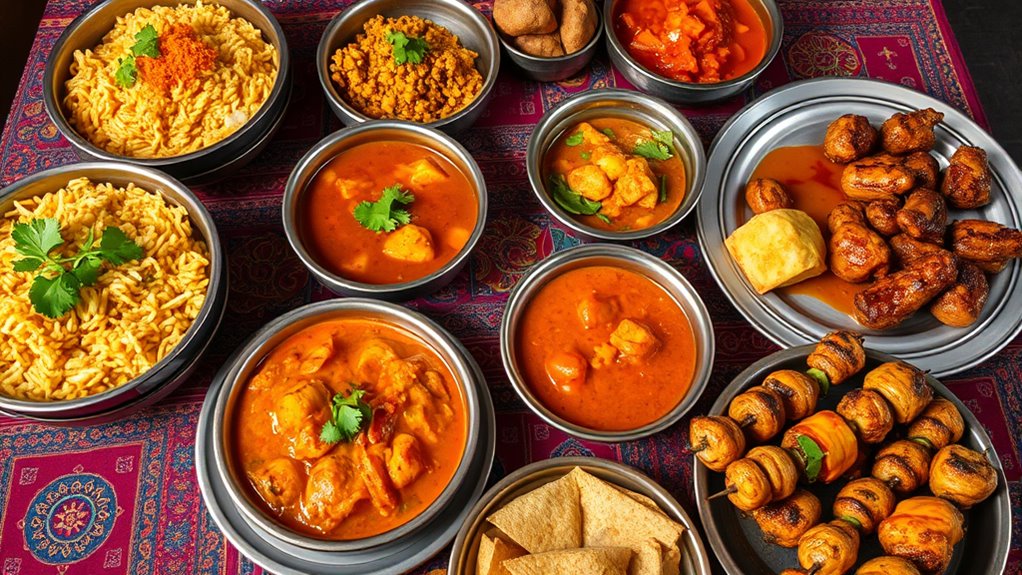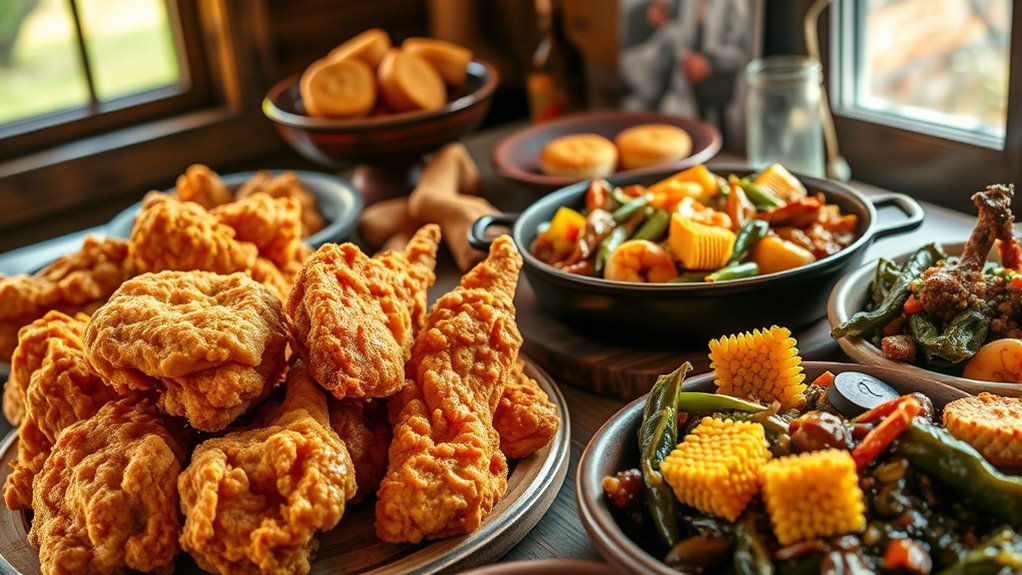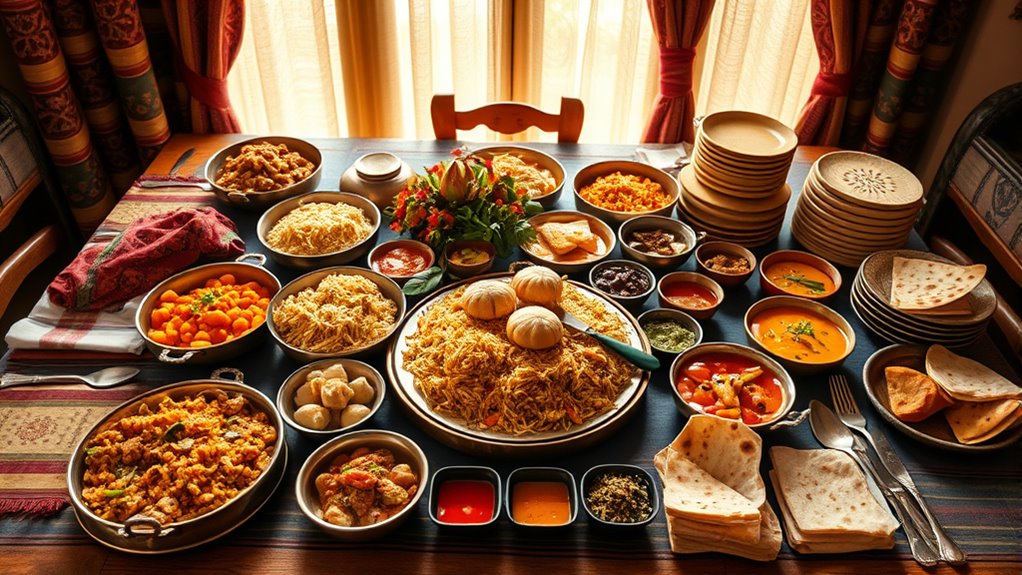Southern cuisine features hearty dishes rooted in African, Native American, European, and Latin influences. You’ll find staples like fried chicken, pork, seafood, and cornbread, with regional flavors shining in dishes like gumbo, barbecue, and shrimp and grits. This diverse food tradition emphasizes bold flavors, cultural heritage, and innovative twists. Exploring its history and variations reveals a vibrant culinary landscape that’s constantly evolving—if you stay curious, there’s even more to discover.
Key Takeaways
- Southern cuisine features ingredients like chicken, pork, seafood, corn, and vegetables, heavily influenced by African, Native American, and European traditions.
- Regional variations include Cajun, Creole, Low Country, and Appalachian dishes, each with unique flavors and signature recipes.
- Iconic dishes include fried chicken, gumbo, barbecue, shrimp and grits, and cornbread, reflecting diverse cultural influences.
- Modern trends incorporate farm-to-table practices, fusion techniques, and technology to innovate traditional Southern recipes.
- Culinary heritage is preserved through community events, documentation, and appreciation of traditional tools and regional food assets.
Core Ingredients of Southern Cooking

Southern cooking centers around a few key ingredients that define its rich and hearty flavors. You’ll find chicken, pork, and beef at the heart of many dishes, with pork being especially popular because it’s affordable and easy to raise. Fresh seafood like catfish and shrimp also plays a big role, especially near coastal and river regions. Vegetables such as greens, beans, and corn are essential, providing freshness and balance. Corn is a staple, used in dishes like grits and cornbread, while herbs like thyme and oregano enhance flavors. These ingredients come together in countless ways, creating the bold, comforting tastes that Southern cuisine is known for. Each ingredient contributes to the region’s culinary identity, rooted in tradition and local availability. Additionally, the use of regional ingredients like okra and sweet potatoes further defines Southern food’s unique character.
Regional Variations and Signature Dishes

Have you ever wondered how diverse the culinary landscape of the South truly is? You’ll find distinct regional flavors that define local identities. In the Low Country, dishes like shrimp and grits showcase Gullah Geechee traditions, blending seafood with hearty grains. Louisiana’s Cajun cuisine bursts with spice in gumbo and jambalaya, reflecting French and African influences. Creole cuisine combines European techniques with local ingredients, producing dishes like beignets. Texas specializes in beef-based barbecue, emphasizing smoky, slow-cooked brisket and ribs. Appalachian regions favor hearty stews and homemade breads, often using game meats like venison. Each area boasts signature dishes that highlight local ingredients, cultural history, and cooking styles—creating a rich mosaic of Southern flavors you can’t find anywhere else. Incorporating mindful decluttering strategies can help preserve and cherish these culinary traditions by maintaining organized and functional kitchen spaces that honor regional specialties.
Cultural Influences Shaping Southern Cuisine

Cultural influences have profoundly shaped the flavors and techniques that define Southern cuisine. You’ll notice African roots in dishes like fried chicken and collard greens, which reflect centuries-old cooking methods and ingredients. Native American traditions introduced staples like corn and squash, forming the base of many recipes. European settlers brought their culinary practices, adding pork, chicken, and baking techniques that remain central today. Latin American influences appear in Tex-Mex dishes, blending spices and ingredients into regional favorites. Additionally, Cajun and Creole cultures in Louisiana combine French, Spanish, and African flavors, creating spicy, vibrant dishes. These diverse traditions merge, giving Southern cuisine its rich tapestry of flavors, techniques, and ingredients that honor a complex history of cultural exchange and adaptation.
Historical Foundations and Their Impact

The foundations of Southern cuisine are deeply rooted in the region’s colonial past, shaped by the influences of European settlers who brought their cooking techniques and ingredients. You’ll notice how French, Spanish, and English traditions merged to create distinctive flavors and dishes. The transatlantic slave trade introduced West African ingredients like okra and techniques such as frying, which became staples in soul food. During the Civil War and Reconstruction, resourcefulness and adaptation shaped hearty, flavorful meals from available ingredients. Immigration patterns brought new spices and culinary ideas, further diversifying the cuisine. The fertile Southern land supported crops like corn, cotton, and tobacco, influencing agricultural practices and the ingredients you now associate with Southern cooking. Additionally, the use of traditional butter making methods contributed to the richness and flavor of many Southern recipes. These historical foundations continue to influence contemporary culinary traditions across the region.
Iconic Southern Food Favorites

Southern fried classics like crispy fried chicken and fluffy biscuits with gravy are true comfort foods. Regional barbecue styles showcase unique flavors, from Memphis’s dry rub to Carolina’s vinegar sauce. These dishes highlight the diverse flavors that define Southern cuisine and its rich culinary heritage. Dynamic communication exercises play a role in sharing and preserving these culinary traditions through storytelling and community bonding.
Southern Fried Classics
Fried foods hold a special place in Southern cuisine, with crispy, golden-brown fried chicken standing out as a beloved classic. You’ll find it served at family gatherings, picnics, and Sunday dinners. Alongside chicken, other fried favorites include catfish, pork chops, and hush puppies. These dishes are cooked with simple ingredients like seasoned flour and hot oil, giving them irresistible crunch and flavor. To understand the variety, here’s a quick look:
| Dish | Main Ingredient | Typical Serving Sides |
|---|---|---|
| Fried Chicken | Chicken | Mashed potatoes, biscuits |
| Catfish | Fish | Coleslaw, hush puppies |
| Pork Chops | Pork | Cornbread, green beans |
These classics capture the essence of Southern comfort food, bringing bold flavors and satisfying textures to the table. Preparation methods play a significant role in achieving the perfect crispy coating.
Regional BBQ Styles
Regional barbecue styles across the South showcase a rich array of flavors and techniques that reflect local history and ingredients. In Memphis, you’ll find dry-rubbed ribs seasoned with a blend of spices, then slow-cooked over hickory wood. Carolina barbecue emphasizes vinegar-based sauces, perfect for pork shoulder or whole hog, offering a tangy, bold flavor. In Texas, beef reigns supreme, often smoked brisket with a simple salt and pepper rub that develops a rich bark. Kansas City barbecue combines sweet and smoky flavors with thick, tomato-based sauce on ribs and burnt ends. Each style highlights regional preferences and ingredients, creating unique culinary identities. Whether you prefer the smoky, tangy, or sweet profiles, exploring these styles reveals Southern barbecue’s diversity and deep-rooted traditions. Additionally, these regional styles often originate from historical influences that have shaped local recipes and cooking techniques over generations.
Modern Trends and Innovations

Have you noticed how chefs today are breathing new life into traditional Southern dishes? They’re reimagining classics by using fresh, locally sourced ingredients and modern cooking techniques. You might see a gourmet twist on fried chicken, pairing it with innovative sauces or unique sides. Fusion cuisine is also making its mark, blending Southern flavors with international influences like Asian spices or Mediterranean herbs. The farm-to-table movement encourages chefs to highlight seasonal produce, ensuring dishes are not only delicious but sustainable. Young chefs are experimenting with presentation, transforming comfort foods into visually stunning plates. These innovations honor tradition while pushing boundaries, making Southern cuisine appealing to a new generation and diverse palates. It’s a dynamic evolution that keeps the culinary scene exciting and relevant. Additionally, some chefs are exploring ethical Hacking principles, such as data security, to ensure that their digital recipes and customer information remain protected as they innovate and share their creations online.
Preserving and Celebrating Culinary Heritage

You can help preserve Southern culinary heritage by supporting efforts to document traditional recipes, ensuring they aren’t lost over time. Participating in community culinary events allows you to celebrate and pass down these authentic flavors to future generations. By engaging with these initiatives, you keep the rich history of Southern cuisine alive and vibrant. Embracing regional variations can deepen your appreciation for the diverse cultural influences that shape Southern food traditions.
Documenting Traditional Recipes
Preserving traditional Southern recipes is essential for maintaining the rich culinary heritage that defines the region. You can do this by recording recipes through handwritten notes, videos, or digital archives, guaranteeing they’re passed down accurately. Documenting these recipes helps capture the techniques, ingredients, and stories behind each dish, keeping them alive for future generations. You might interview elders or local cooks to gather firsthand insights, preserving the cultural context that makes these recipes unique. Sharing these recordings in cookbooks, community events, or online platforms encourages appreciation and awareness. By actively documenting recipes, you ensure that the flavors, traditions, and history of Southern cuisine aren’t lost over time but celebrated and embraced by new generations. Wealth protection strategies can also be employed to safeguard the cultural assets associated with these culinary traditions, ensuring their preservation for the future.
Community Culinary Events
Community culinary events serve as vibrant gatherings that celebrate and uphold Southern food traditions. By participating, you help preserve recipes passed down through generations, keeping culinary heritage alive. These events often feature cook-offs, festivals, and farmers’ markets where locals share signature dishes like fried chicken, gumbo, and cornbread. You can learn new techniques, swap recipes, and connect with others passionate about Southern cuisine. Such gatherings foster pride in regional flavors and cultural history, offering a space to honor diverse influences like African, Native American, and European roots. Whether you’re volunteering, competing, or simply tasting, your involvement keeps culinary traditions thriving and encourages younger generations to appreciate and continue Southern food heritage. These events turn food into a shared cultural experience. Additionally, understanding the home essentials used in traditional Southern cooking can enhance your appreciation of authentic flavors.
Frequently Asked Questions
How Do Southern Cooking Techniques Differ Across Regions?
You’ll notice regional differences in Southern cooking techniques based on local ingredients and cultural influences. In Louisiana, chefs often use roux and slow simmering for gumbo and jambalaya, while in Texas, smoking and grilling dominate barbecue styles. In the Appalachian region, you might see more home-cooked methods like baking breads and stewing game meats. These variations reflect distinct histories, climates, and available resources across the South, shaping each area’s unique culinary approach.
What Role Do Family Traditions Play in Southern Culinary Practices?
Family traditions play a essential role in Southern culinary practices by shaping recipes, cooking methods, and meal customs. You often pass down cherished dishes and techniques through generations, creating a sense of identity and community. These traditions influence special occasions, like Sunday dinners or holiday feasts, where recipes are preserved and celebrated. By maintaining family food customs, you keep Southern culture alive and foster connections across generations.
How Have Modern Health Trends Influenced Southern Recipes?
You’ve probably noticed Southern recipes now incorporate healthier ingredients, like replacing fried chicken with grilled options. Modern health trends push you to swap butter for olive oil or add more vegetables, transforming traditional dishes into lighter versions. For example, some chefs use cauliflower rice instead of grits. This shift is like turning a classic song into a fresh remix—respecting tradition while embracing new rhythms for better health.
What Are Some Lesser-Known Southern Ingredients Gaining Popularity?
You’ll notice lesser-known Southern ingredients gaining popularity, like collard green stems, which add crunch and flavor, and heirloom vegetables like Cherokee purple tomatoes. Also, ingredients like sorghum syrup are making a comeback as natural sweeteners, while local wild herbs such as ramps are becoming favorites in modern dishes. These ingredients give traditional recipes a fresh twist, connecting you more deeply to the region’s rich culinary heritage.
How Is Southern Cuisine Adapting to Global Culinary Influences?
You’ll find Southern cuisine embracing global influences much like a jazz musician improvising over a familiar tune. Chefs now blend spices from India, Asia, and beyond into traditional dishes, creating exciting fusion flavors. For example, some serve Cajun jambalaya with Thai basil or African-inspired seasonings. This culinary evolution keeps Southern food vibrant and relevant, just like a lively dance that respects its roots but moves confidently into new rhythms.
Conclusion
As you plunge into the rich tapestry of Southern cuisine, you’re tasting more than just flavors—you’re savoring centuries of history, culture, and passion. Each dish is a story simmered to perfection, a melody of tradition and innovation dancing on your palate. Embrace these culinary treasures, and let them inspire you to keep the flame of Southern heritage alive. After all, these recipes are the heartbeat of a vibrant, timeless soul.









